KACES Newsletter Vol.10
1970
January 1
January 1
© 1970 KACES
FOCUS ARTICLES
The importance of artistic engagement for older adults and Creative Aging
The stigma of aging
In the span of time we have been working with older adults (Merced since 1987, Lokon since 2006), we have addressed many misconceptions about aging and creativity. Before the concept of Creative Aging became known, it was common for people to think of the idea of older adult creativity as something associated with few famous actors, opera singers, or musicians with unusually long careers.
The notion that ordinary older adults can be creative was, and to some extent still is, considered unrealistic or even impossible. There is a widely generalized sense that as we grow older we lose the need and capacity to be creative. Creativity is routinely associated with youth while aging is typically associated with decline in physical and mental health. As people age, medical care and basic social services are prioritized, with the expectation of gradual withdrawal from creativity and the arts.
The perception that older adults cannot be creative is even stronger if they are diagnosed with Alzheimer’s disease or other forms of dementia. Age is the primary risk factor for developing dementia. The older we get, the higher the risk. With the rapidly aging societies in the world, especially in Korea, the number of people with dementia will only increase. In Korea alone, currently there are over 725,000 people living with dementia. In 2030, this number will increase to1.2 million and in 2050 to 2.7 million people[1]. So, how can the arts be applied to improve the quality of life of older adults in general and older adults with dementia in particular?
Creative Aging, addressing the stigma of aging
Creative Aging proposes an inclusive and flexible framework for building artistic engagement opportunities across the entire lifespan: from youth to older adults, including older adults with dementia. We include “youth” here because we are all aging from the moment we are born. The truth is that everyone gets older all the time.
Creative Aging philosophy and practice champions creativity as an important life-long support for quality of life. It challenges societies to develop the collective agency required for all members to lead culturally resonant lives, in dynamic connection and dialogue with the arts and art-making, supported by sustained social interactions, and nurtured by lifelong arts learning goals.
Many research studies show that creativity and artistic engagement are key components to the well-being of older adults[2]. Engaging in the arts can also reduce the risk of dementia[3]. The arts can give people the opportunity to tap their imagination and express their creativity without having to rely on fading memories or declining mental faculties.
In Creative Aging, we start by acknowledging that the arts are all around us. The arts and art-making are vital practices through which all age groups in all societies can express identity and belonging, heritage and change, human potential and actualization. Seen from this perspective, Creative Aging proponents believe that older adults have as much right to contribute as everyone else.
Creative Aging focuses on the assets that accrue with aging, not its costs or losses. It honors the full range of life experiences in older adult populations, and each older adult’s sustained ability to express and create value for society. It allocates resources for learning and gives older adults a voice in establishing the best standards of care.
Two example programs in Creative Aging
In New York City, Pregones PRTT[4] (https://pregonesprtt.org/) has been creating and implementing interactive arts learning programs for older adults since the 1980s. This work is driven by a commitment to providing older adults with direct access to practicing artists via hands-on workshops in collective theater practice and supporting dialogues about culture, wellness, and quality of life. Engagement initiatives include free/low-cost admission to professional performances; multi-month residencies at local senior centers; multiple Living History theater festivals featuring performances and presentations of works created by older adults; interactive forum theater plays, in the style of Augusto Boal, addressing difficult societal issues, such as domestic violence; and the engagement of inter-generational teams to collect oral histories in multiple languages. Thousands of older adults have participated in the creation, performance and appreciation of live theater throughout the years.
In Ohio, The Opening Minds through Art or OMA program (www.ScrippsOMA.org) provides people living with dementia with the opportunity to create abstract art and build friendships with high school or college students paired with them on a weekly basis. The program is based at Miami University in Ohio and is now offered at over 150 facilities around North America. Recognizing the social distance across generations and the lack of appreciation for older people in general and older people with dementia in particular, OMA set out to create social change one person at a time. The weekly art-making for the entire semester brings elders and students closer, transcending the age divide. Students typically start out with some degree of apprehension and anxiety but by the end of the term, they develop a deep appreciation for the friendships, or even kinship they feel with their elder partners. For the elders, living alone or living in a nursing home can be a very isolating existence. The weekly arrival of student volunteers brings them joy. Their finished art pieces are exhibited in art shows attended by proud relatives and their student partners, who also bring their families and friends. These community events bring together people from across the generations and boost the elders' self-esteem, while promoting transformative learning for the students.
The commonality between the two Creative Aging programs above is that both programs tap people’s imagination and provide opportunities for social connections. Both of which contribute positively to the well-being of older adults as well as people living with dementia.
In the span of time we have been working with older adults (Merced since 1987, Lokon since 2006), we have addressed many misconceptions about aging and creativity. Before the concept of Creative Aging became known, it was common for people to think of the idea of older adult creativity as something associated with few famous actors, opera singers, or musicians with unusually long careers.
The notion that ordinary older adults can be creative was, and to some extent still is, considered unrealistic or even impossible. There is a widely generalized sense that as we grow older we lose the need and capacity to be creative. Creativity is routinely associated with youth while aging is typically associated with decline in physical and mental health. As people age, medical care and basic social services are prioritized, with the expectation of gradual withdrawal from creativity and the arts.
The perception that older adults cannot be creative is even stronger if they are diagnosed with Alzheimer’s disease or other forms of dementia. Age is the primary risk factor for developing dementia. The older we get, the higher the risk. With the rapidly aging societies in the world, especially in Korea, the number of people with dementia will only increase. In Korea alone, currently there are over 725,000 people living with dementia. In 2030, this number will increase to1.2 million and in 2050 to 2.7 million people[1]. So, how can the arts be applied to improve the quality of life of older adults in general and older adults with dementia in particular?
Creative Aging, addressing the stigma of aging
Creative Aging proposes an inclusive and flexible framework for building artistic engagement opportunities across the entire lifespan: from youth to older adults, including older adults with dementia. We include “youth” here because we are all aging from the moment we are born. The truth is that everyone gets older all the time.
Creative Aging philosophy and practice champions creativity as an important life-long support for quality of life. It challenges societies to develop the collective agency required for all members to lead culturally resonant lives, in dynamic connection and dialogue with the arts and art-making, supported by sustained social interactions, and nurtured by lifelong arts learning goals.
Many research studies show that creativity and artistic engagement are key components to the well-being of older adults[2]. Engaging in the arts can also reduce the risk of dementia[3]. The arts can give people the opportunity to tap their imagination and express their creativity without having to rely on fading memories or declining mental faculties.
In Creative Aging, we start by acknowledging that the arts are all around us. The arts and art-making are vital practices through which all age groups in all societies can express identity and belonging, heritage and change, human potential and actualization. Seen from this perspective, Creative Aging proponents believe that older adults have as much right to contribute as everyone else.
Creative Aging focuses on the assets that accrue with aging, not its costs or losses. It honors the full range of life experiences in older adult populations, and each older adult’s sustained ability to express and create value for society. It allocates resources for learning and gives older adults a voice in establishing the best standards of care.
Two example programs in Creative Aging
In New York City, Pregones PRTT[4] (https://pregonesprtt.org/) has been creating and implementing interactive arts learning programs for older adults since the 1980s. This work is driven by a commitment to providing older adults with direct access to practicing artists via hands-on workshops in collective theater practice and supporting dialogues about culture, wellness, and quality of life. Engagement initiatives include free/low-cost admission to professional performances; multi-month residencies at local senior centers; multiple Living History theater festivals featuring performances and presentations of works created by older adults; interactive forum theater plays, in the style of Augusto Boal, addressing difficult societal issues, such as domestic violence; and the engagement of inter-generational teams to collect oral histories in multiple languages. Thousands of older adults have participated in the creation, performance and appreciation of live theater throughout the years.
In Ohio, The Opening Minds through Art or OMA program (www.ScrippsOMA.org) provides people living with dementia with the opportunity to create abstract art and build friendships with high school or college students paired with them on a weekly basis. The program is based at Miami University in Ohio and is now offered at over 150 facilities around North America. Recognizing the social distance across generations and the lack of appreciation for older people in general and older people with dementia in particular, OMA set out to create social change one person at a time. The weekly art-making for the entire semester brings elders and students closer, transcending the age divide. Students typically start out with some degree of apprehension and anxiety but by the end of the term, they develop a deep appreciation for the friendships, or even kinship they feel with their elder partners. For the elders, living alone or living in a nursing home can be a very isolating existence. The weekly arrival of student volunteers brings them joy. Their finished art pieces are exhibited in art shows attended by proud relatives and their student partners, who also bring their families and friends. These community events bring together people from across the generations and boost the elders' self-esteem, while promoting transformative learning for the students.
The commonality between the two Creative Aging programs above is that both programs tap people’s imagination and provide opportunities for social connections. Both of which contribute positively to the well-being of older adults as well as people living with dementia.
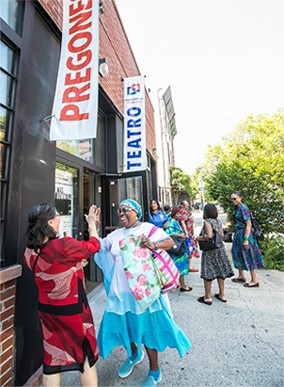
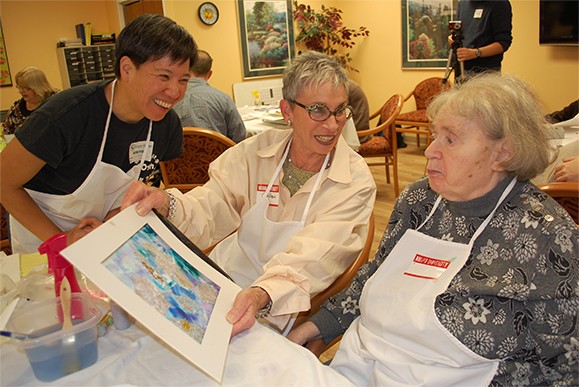
KACES Creative Aging training
Contributing to KACES’ dynamic exploration of creative aging principles, we joined Arte Academy 2018 in Korea, leading the workshop “Building Capacity: Aging Creatively in the Community.” With the help of talented interpreters, we engaged 48 teaching artists in two consecutive three-day intensive training sessions. The training contents include: An overview of the philosophy and history of Creative Aging including a review of seminal studies; the impact of rapidly aging societies around the world and specifically in Korea; a detailed analysis of the principles of working with people who have dementia; a look at the World Health Organization’s call for Age Friendly Cities, and it’s potential application to Korea. Participants also received hands-on training on specific creative aging teaching techniques in theater and visual arts.
Training participants deeply explored their dual role as artists and teachers. They learned how to adapt their teaching methodology to include Creative Aging principles. They became more adept at changing their use of language when collecting oral histories, which were used as a basis for creating original plays. And most importantly, they learned how to provide constructive feedback so that others’ creative expression may be enhanced, regardless of their age or cognitive abilities.
We look forward to seeing this group of artists take the lead in developing an inclusive and multi-disciplined artistic engagement for older adults of all ages and abilities in Korea.
Contributing to KACES’ dynamic exploration of creative aging principles, we joined Arte Academy 2018 in Korea, leading the workshop “Building Capacity: Aging Creatively in the Community.” With the help of talented interpreters, we engaged 48 teaching artists in two consecutive three-day intensive training sessions. The training contents include: An overview of the philosophy and history of Creative Aging including a review of seminal studies; the impact of rapidly aging societies around the world and specifically in Korea; a detailed analysis of the principles of working with people who have dementia; a look at the World Health Organization’s call for Age Friendly Cities, and it’s potential application to Korea. Participants also received hands-on training on specific creative aging teaching techniques in theater and visual arts.
Training participants deeply explored their dual role as artists and teachers. They learned how to adapt their teaching methodology to include Creative Aging principles. They became more adept at changing their use of language when collecting oral histories, which were used as a basis for creating original plays. And most importantly, they learned how to provide constructive feedback so that others’ creative expression may be enhanced, regardless of their age or cognitive abilities.
We look forward to seeing this group of artists take the lead in developing an inclusive and multi-disciplined artistic engagement for older adults of all ages and abilities in Korea.
△ 2018 Arte Academy "Building Capacity: Aging Creatively in the Community" Workshop
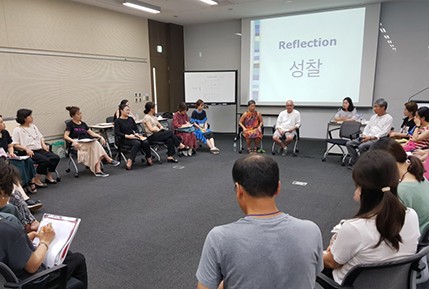
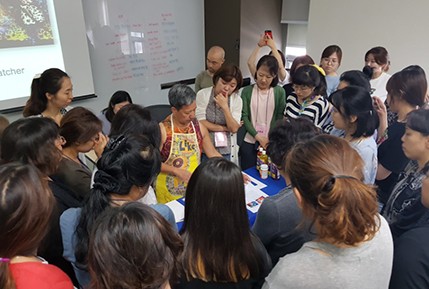
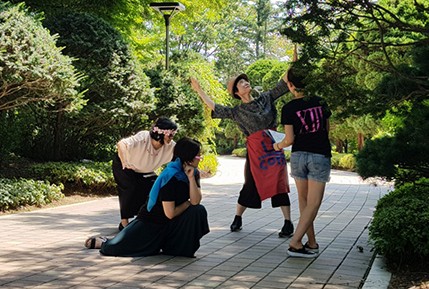
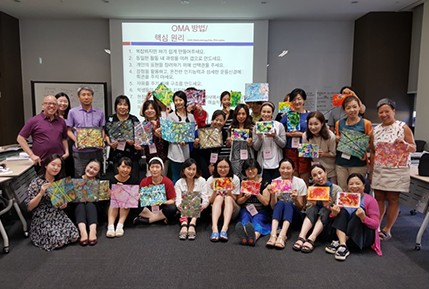
Recognized as the fastest aging country in the world, Korea is uniquely placed to lead the way in new and dynamic artistic engagement initiatives for older adults. We believe Creative Aging provides a multi-sector opportunity for partnerships that range from individual households to public services and industry in Korea. Creative Aging is a society-wide need requiring solutions that are resource and time intensive. Participants of Arte Academy proved they are ready for the task. This is an extraordinary opportunity for public-private partnership to elevate the quality of life for older adults, caregivers and society through the arts, not just in Korea but the rest of the world. To conclude, we would like to quote one of KACES training participants who wrote in the workshop evaluation, “It's a new frontier area and it's very exciting.”
*Posted by Jorge Merced and Elizabeth “Like” Lokon(Board of NCCA)
*Posted by Jorge Merced and Elizabeth “Like” Lokon(Board of NCCA)
© 1970 KACES
Open letter to Museum: Museum, Culture and Education in social and political convulsing times
We are living in a very troubled times, watching the world turns dangerously to a radical political and social positions all around the world. The many efforts expended to a more equalitarian and fair society since 1970’s looks far away now, and old generations should feel disappointed and frustrated with an impression of throwback history.
From 1970’s, taking as basis the document from Santiago de Chile round table[1], museums should be concerned by their duties and role at social landscape, chasing new activities, propositions and attitudes.
At that document, the museums were called to a new commitment to collaborate for the social transformations needed, using their collections, spaces, professionals and expertise to educate societies in a critical way, aiming the autonomy of individuals for a better world.
This process, which in a way, could be resumed by the phase “turn museums from temples to forums”, proposed a notion called Integral Museum, able to deal with economic inequalities, social development, ecologic and urbanistic scenario, educational responsibility through Culture. A tough work!
Nowadays, facing again a very similar situation in terms of political and social development, do museums fulfill the desires and dreams expressed at that document?
I can just answer this question from my point of view, as a Brazilian museum worker and current president of CECA-ICOM, the Committee for Education and Cultural Action of the International Council of Museums. From this position, I was able to see activities of museums worldwide, both in terms of exhibition and educational activities. From this perspective, and agreeing with what Hughes de Varine-Bohan presented at his text Museums and social development: a critical balance[2], it seems that while ecomuseums hatched in different parts of the world, connecting community and culture; a very small number of traditional museums changed their plot to a more engaged attitude with society. If they did that change, they made it mainly through their Education Departments.
Besides the evident true and common sense that museums are natural educational environments, the specialization of museum professionals and the very intricate discourse of researchers, conservators and curators built a gap from their interests (and exhibition propositions) and visitor´s interests. This phenomenon, visible for instance through wall texts of the major part of the museums, in face of which the current public needs: a dictionary, a course of history of art, a course of science discoveries, a huge historical background and knowledge about political and economic current issues, shows how apart these two worlds are. 1972’s document already had proposed that museum professionals must pass through a huge change aiming to developing a more inclusive museum, and almost fifty years later it seems that this path was not taken.
Nowadays, although from outside it seems that museums around the world launch exhibitions and catalogues reviewing their own collections trying to fight against big “historical evils” like colonialism, patriarchate, racism and all kind of discrimination, in a very welcome review; from inside the hard organizational hierarchy is still on. Big part of museums still maintain at the top of their organizational structure the professionals connected with the objects (collections, concepts and research), and in a far down platform the professionals that deals with the public. Despite their efforts of external “descolonialization”, internally, the colonial structure is still on.
The position maintained by the researchers and curators, far from public and from other museums professionals, is a dangerous position. If the museum do not really connect with society, what could be its relevance?
In a XXI century world with a prolific amount of images, endless social media that spread equally fake and true news, that the web is currently on our disposition in a mouse click; society needs a safe place capable do develop critical thinking capacities.
That is why in our world culture and education are not ‘just’ important, are urgent.
Why do we need education in museum?
This context could lead people to believe that the role of museum education is to ‘translate’ the institution discourse to public. However, this is the most insignificant role of museum education. Why insignificant? Because doing so is just about give people information, that actually they do not even want.
Trying to bring awareness about the potentiality of museum education, a group of Brazilian professionals developed a National Policies for Museum Education (PNEM), and a posterior publication explaining the collective process of its development, plus a small glossary. At that last one, we try to define our role as:
‘Museum education puts science, memory and cultural heritage in perspective as products of mankind, and at the same time helps individuals to inter-relate and produce a new understanding and new practices mediated by objects, knowledges and activities. Museum education also has its own structure and organization, and as such can relate to realities outside the museum according to the goals set forth in its planning. Its actions are fundamentally based on dialogue, which includes acknowledging and appropriating musealized heritage and reflecting on its history, composition and legitimacy as regards the different cultural groups that make up society. In this connection, museum education is a piece inside the complex mechanism of the individual’s general education in society. It doesn’t focus on objects or collections; rather, its focus is on the formation of individual subjects in their interaction with musealized assets, museum professionals and their visiting experience. More than ‘developing visitors’ or ‘training the audience’, museum education works toward a full critical education of individuals, their emancipation and their conscious action in society, with a view to social transformation.’[3]
If museums does not turn their interests to people, to society, these institutions has no future. In a society focused on products and consumption, where objects and images develop a fundamental role in our daily lives, museum has a duty to improve the appreciation beyond the aesthetics perception towards knowledge and abilities like critical thinking, discernment, analysis, respect for memory and heritage, dialogue, ethic, tolerance etc. and all these could be made just through museum education.
The theorist Mark O'Neill[4] says that "The implications for the fact that inclusion and exclusion processes are self-reinforced / generated are very clear: any organization that is not working to break the barriers are actively maintaining them. Neutrality is not possible." Thus, the museum has the duty and commitment to act actively to break down those barriers and to build a critical citizenship, which may be its most important mission.
How can we provide richer (art) experiences for children, adults, disabled people, elderly and other audiences?”
Listen to people instead to provide meaningless information. As museum and educators we have a tendency to “teach” in a formal way, based in an old believe that provide information is synonymous of build knowledge. It is not.
As George Hein[5] said, to build meaningful knowledge the constructivist museum has to consider that learners are able to construct their own knowledge and that the learner constructs all the knowledge needed.
It seems obvious, but is not. Since museums are still in its own closed world, most part of the staff believes that learn is transmission of information. However, what relevance could have to an intellectual disabled person to know the technique of an artwork or the correct date of its production?
In front of an artwork, this person is completely able to express in which way this object or image is related with his/her life and make connections between art and quotidian life better than anyone else. From these connections on, the educator can help the visitor to develop deeper meanings and connect individual to collective ones.
This way, beyond generating knowledge about Art, History, Archeology, Sciences, etc., the museum has to build knowledge about “being in the world”, what we are doing here, who we are, and how we can build another reality, better and more equitable for all.
From 1970’s, taking as basis the document from Santiago de Chile round table[1], museums should be concerned by their duties and role at social landscape, chasing new activities, propositions and attitudes.
At that document, the museums were called to a new commitment to collaborate for the social transformations needed, using their collections, spaces, professionals and expertise to educate societies in a critical way, aiming the autonomy of individuals for a better world.
This process, which in a way, could be resumed by the phase “turn museums from temples to forums”, proposed a notion called Integral Museum, able to deal with economic inequalities, social development, ecologic and urbanistic scenario, educational responsibility through Culture. A tough work!
Nowadays, facing again a very similar situation in terms of political and social development, do museums fulfill the desires and dreams expressed at that document?
I can just answer this question from my point of view, as a Brazilian museum worker and current president of CECA-ICOM, the Committee for Education and Cultural Action of the International Council of Museums. From this position, I was able to see activities of museums worldwide, both in terms of exhibition and educational activities. From this perspective, and agreeing with what Hughes de Varine-Bohan presented at his text Museums and social development: a critical balance[2], it seems that while ecomuseums hatched in different parts of the world, connecting community and culture; a very small number of traditional museums changed their plot to a more engaged attitude with society. If they did that change, they made it mainly through their Education Departments.
Besides the evident true and common sense that museums are natural educational environments, the specialization of museum professionals and the very intricate discourse of researchers, conservators and curators built a gap from their interests (and exhibition propositions) and visitor´s interests. This phenomenon, visible for instance through wall texts of the major part of the museums, in face of which the current public needs: a dictionary, a course of history of art, a course of science discoveries, a huge historical background and knowledge about political and economic current issues, shows how apart these two worlds are. 1972’s document already had proposed that museum professionals must pass through a huge change aiming to developing a more inclusive museum, and almost fifty years later it seems that this path was not taken.
Nowadays, although from outside it seems that museums around the world launch exhibitions and catalogues reviewing their own collections trying to fight against big “historical evils” like colonialism, patriarchate, racism and all kind of discrimination, in a very welcome review; from inside the hard organizational hierarchy is still on. Big part of museums still maintain at the top of their organizational structure the professionals connected with the objects (collections, concepts and research), and in a far down platform the professionals that deals with the public. Despite their efforts of external “descolonialization”, internally, the colonial structure is still on.
The position maintained by the researchers and curators, far from public and from other museums professionals, is a dangerous position. If the museum do not really connect with society, what could be its relevance?
In a XXI century world with a prolific amount of images, endless social media that spread equally fake and true news, that the web is currently on our disposition in a mouse click; society needs a safe place capable do develop critical thinking capacities.
That is why in our world culture and education are not ‘just’ important, are urgent.
Why do we need education in museum?
This context could lead people to believe that the role of museum education is to ‘translate’ the institution discourse to public. However, this is the most insignificant role of museum education. Why insignificant? Because doing so is just about give people information, that actually they do not even want.
Trying to bring awareness about the potentiality of museum education, a group of Brazilian professionals developed a National Policies for Museum Education (PNEM), and a posterior publication explaining the collective process of its development, plus a small glossary. At that last one, we try to define our role as:
‘Museum education puts science, memory and cultural heritage in perspective as products of mankind, and at the same time helps individuals to inter-relate and produce a new understanding and new practices mediated by objects, knowledges and activities. Museum education also has its own structure and organization, and as such can relate to realities outside the museum according to the goals set forth in its planning. Its actions are fundamentally based on dialogue, which includes acknowledging and appropriating musealized heritage and reflecting on its history, composition and legitimacy as regards the different cultural groups that make up society. In this connection, museum education is a piece inside the complex mechanism of the individual’s general education in society. It doesn’t focus on objects or collections; rather, its focus is on the formation of individual subjects in their interaction with musealized assets, museum professionals and their visiting experience. More than ‘developing visitors’ or ‘training the audience’, museum education works toward a full critical education of individuals, their emancipation and their conscious action in society, with a view to social transformation.’[3]
If museums does not turn their interests to people, to society, these institutions has no future. In a society focused on products and consumption, where objects and images develop a fundamental role in our daily lives, museum has a duty to improve the appreciation beyond the aesthetics perception towards knowledge and abilities like critical thinking, discernment, analysis, respect for memory and heritage, dialogue, ethic, tolerance etc. and all these could be made just through museum education.
The theorist Mark O'Neill[4] says that "The implications for the fact that inclusion and exclusion processes are self-reinforced / generated are very clear: any organization that is not working to break the barriers are actively maintaining them. Neutrality is not possible." Thus, the museum has the duty and commitment to act actively to break down those barriers and to build a critical citizenship, which may be its most important mission.
How can we provide richer (art) experiences for children, adults, disabled people, elderly and other audiences?”
Listen to people instead to provide meaningless information. As museum and educators we have a tendency to “teach” in a formal way, based in an old believe that provide information is synonymous of build knowledge. It is not.
As George Hein[5] said, to build meaningful knowledge the constructivist museum has to consider that learners are able to construct their own knowledge and that the learner constructs all the knowledge needed.
It seems obvious, but is not. Since museums are still in its own closed world, most part of the staff believes that learn is transmission of information. However, what relevance could have to an intellectual disabled person to know the technique of an artwork or the correct date of its production?
In front of an artwork, this person is completely able to express in which way this object or image is related with his/her life and make connections between art and quotidian life better than anyone else. From these connections on, the educator can help the visitor to develop deeper meanings and connect individual to collective ones.
This way, beyond generating knowledge about Art, History, Archeology, Sciences, etc., the museum has to build knowledge about “being in the world”, what we are doing here, who we are, and how we can build another reality, better and more equitable for all.
[1] The round table of Santiago (Chile), Museums and Society in Latin America. http://unesdoc.unesco.org/images/0012/001273/127362eo.pdf
[2] In: BRUNO, Maria Cristina Oliveira; NEVES, Kátia Regina Felipini (coord.). Museums as agents of social change and development: museological proposals and reflections. São Cristóvão: Museum of Archeology of Xingó, 2008. pp.11-20.
[4] O'NEILL, Mark, "The good enough visitor." In: Sandell, Richard (ed.) Museums, society, inequality, London & NY: Routledge, 2002.
[5] HEIN, George. The constructivist Museum. In: Hein, George. Learning in the Museum. London: Routledge, 1998.
* Posted by Milene Chiovatto
Milene Chiovatto is currently President of CECA/ ICOM (Committee on Education and Cultural Action of the International Council of Museums) and Head of Education Department at Pinacoteca de São Paulo, Brasil, since 2002. Holds a degree in arts education at Mackenzie University; Master in Communication Sciences - Sociology of Art at School of Communication Arts, São Paulo´s University. Former Art History teacher at Armando Alvares Penteado Foundation (FAAP) School of Communication. Member of American Alliance of Museums and counselor of the Instituto Arte na Escola (2007-2013). Educational consultant and author of pedagogical publications in arts.
Milene Chiovatto is currently President of CECA/ ICOM (Committee on Education and Cultural Action of the International Council of Museums) and Head of Education Department at Pinacoteca de São Paulo, Brasil, since 2002. Holds a degree in arts education at Mackenzie University; Master in Communication Sciences - Sociology of Art at School of Communication Arts, São Paulo´s University. Former Art History teacher at Armando Alvares Penteado Foundation (FAAP) School of Communication. Member of American Alliance of Museums and counselor of the Instituto Arte na Escola (2007-2013). Educational consultant and author of pedagogical publications in arts.
© 1970 KACES
New Spaces for Teaching Artistry
Since the movement began, Teaching Artists have had to work in classrooms and communities with the resources and spaces they were given. The business of the Teaching Artist has been to apply those skills in a range of spaces. As a musician or visual artist, writer or dancer, they have had to work with a space that is rarely ideal. Classrooms often contain a range of expectations for the participants, the artists and the teachers, as well as being cluttered with other learning resources, while halls and community spaces can sometimes feel too temporary or makeshift.
Many galleries, community hubs and libraries now contain allocated areas for making activities, often specifically for children. In Australia, for example, many new libraries contain ‘Maker Spaces’ and every major gallery has a family creative activity area – usually associated with the current exhibition.
However, in the last twenty years there has begun a new international movement of spaces specifically designed to house teaching artistry. The Ark in Dublin, ArtPlay in Melbourne and
Playeum in Singapore each represent purpose designed spaces for intergenerational creative activity lead by Teaching Artists. Each of these examples offer flexible and dynamic designed spaces for a range of creative activities. The nature of these spaces help to support the practice of the Teaching Artists and, to be successful, need to reflect and complement that practice.
The Ark was Europe’s first purpose built cultural centre for children, developed as part of an urban regeneration project following Dublin as European City of Culture in 1990. The Ark has a purpose- built theatre for children, top-floor workshop for artists-in-residence and exhibition space for work by, with, for and about children. Playeum formed as a response to a very controlled curriculum of activities for young children in Singapore and engages artists to design interactive exhibitions and workshops for children and families in a space based in the gallery precinct of the city. ArtPlay is a City Council driven program of activities for children and families in the heart of Melbourne, Australia, sited in an old train repair warehouse and has become a national example of best practice.
Many galleries, community hubs and libraries now contain allocated areas for making activities, often specifically for children. In Australia, for example, many new libraries contain ‘Maker Spaces’ and every major gallery has a family creative activity area – usually associated with the current exhibition.
However, in the last twenty years there has begun a new international movement of spaces specifically designed to house teaching artistry. The Ark in Dublin, ArtPlay in Melbourne and
Playeum in Singapore each represent purpose designed spaces for intergenerational creative activity lead by Teaching Artists. Each of these examples offer flexible and dynamic designed spaces for a range of creative activities. The nature of these spaces help to support the practice of the Teaching Artists and, to be successful, need to reflect and complement that practice.
The Ark was Europe’s first purpose built cultural centre for children, developed as part of an urban regeneration project following Dublin as European City of Culture in 1990. The Ark has a purpose- built theatre for children, top-floor workshop for artists-in-residence and exhibition space for work by, with, for and about children. Playeum formed as a response to a very controlled curriculum of activities for young children in Singapore and engages artists to design interactive exhibitions and workshops for children and families in a space based in the gallery precinct of the city. ArtPlay is a City Council driven program of activities for children and families in the heart of Melbourne, Australia, sited in an old train repair warehouse and has become a national example of best practice.
△ Artplay
△Playeum
△The Ark

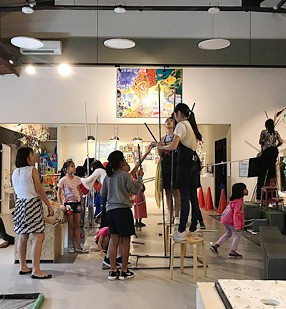
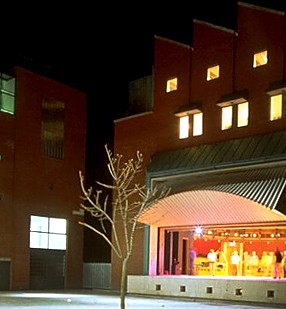
On my recent invitation to Korea by KACES I was pleased to visit some new exciting initiatives that are part of this international movement to refurbish existing buildings and creating exciting new opportunities for community creativity and connectivity.
Our key forum was at B39 in Seoul. This old incinerator building houses galleries and activity spaces for a broad community and oozes creativity. It has, like many of these buildings, found the balance between an efficient industrial design style while retaining the soul of the building. A common factor of many of these refurbishments is to embrace and share the many previous lives and stories of the structure yet appear fresh and dynamic to new users. B39 is a fabulous space with so much potential– revitalizing an area of the city and offering new opportunities for creative exchange. In the forum itself many ideas and projects were shared, showing a real desire to exploit similar structures across the country to offer new creative spaces for intergenerational groups to gather, make and share.
My second day in Korea took us out of the city to visit Jeonju City in the Northern Jeolia Province. Travelling with Fran Edgerley from ‘assemble’ in the UK, I had the opportunity to see two new initiatives in action. Both the Art-Police centre in Deokjin and the Factory in Palbok demonstrated a commitment to re-utilising spaces for community gathering and creativity. The small police house, included multiple spaces with intriguing and thoughtful names (“sometimes together”, “often by myself” and “always a room with noise”) provides an unusual mix of arts activity, art therapy and domesticity on a human scale. The Factory in Palbok couldn’t be more different in many ways: a large scale building with enormous spaces but with plans for redevelopment imminent. Both spaces, although very different, actually offer the same set of common factors that enable creative intergenerational participation.
In a forum at the Factory in Palbok three other projects were shared with a group of representatives from local cultural and arts organisations, local government staff and individual artists. It was clear that there were common factors linking all these initiatives, both in the forum and in the examples we had visited. So what are these factors?
Our key forum was at B39 in Seoul. This old incinerator building houses galleries and activity spaces for a broad community and oozes creativity. It has, like many of these buildings, found the balance between an efficient industrial design style while retaining the soul of the building. A common factor of many of these refurbishments is to embrace and share the many previous lives and stories of the structure yet appear fresh and dynamic to new users. B39 is a fabulous space with so much potential– revitalizing an area of the city and offering new opportunities for creative exchange. In the forum itself many ideas and projects were shared, showing a real desire to exploit similar structures across the country to offer new creative spaces for intergenerational groups to gather, make and share.
My second day in Korea took us out of the city to visit Jeonju City in the Northern Jeolia Province. Travelling with Fran Edgerley from ‘assemble’ in the UK, I had the opportunity to see two new initiatives in action. Both the Art-Police centre in Deokjin and the Factory in Palbok demonstrated a commitment to re-utilising spaces for community gathering and creativity. The small police house, included multiple spaces with intriguing and thoughtful names (“sometimes together”, “often by myself” and “always a room with noise”) provides an unusual mix of arts activity, art therapy and domesticity on a human scale. The Factory in Palbok couldn’t be more different in many ways: a large scale building with enormous spaces but with plans for redevelopment imminent. Both spaces, although very different, actually offer the same set of common factors that enable creative intergenerational participation.
In a forum at the Factory in Palbok three other projects were shared with a group of representatives from local cultural and arts organisations, local government staff and individual artists. It was clear that there were common factors linking all these initiatives, both in the forum and in the examples we had visited. So what are these factors?
△Cultural Precinct Station(Deokjin)
△Site visit at Palbok
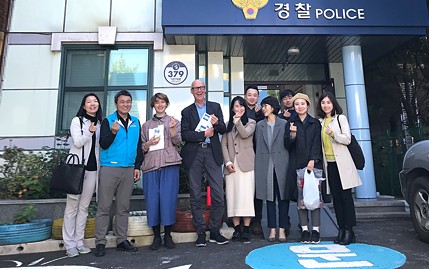
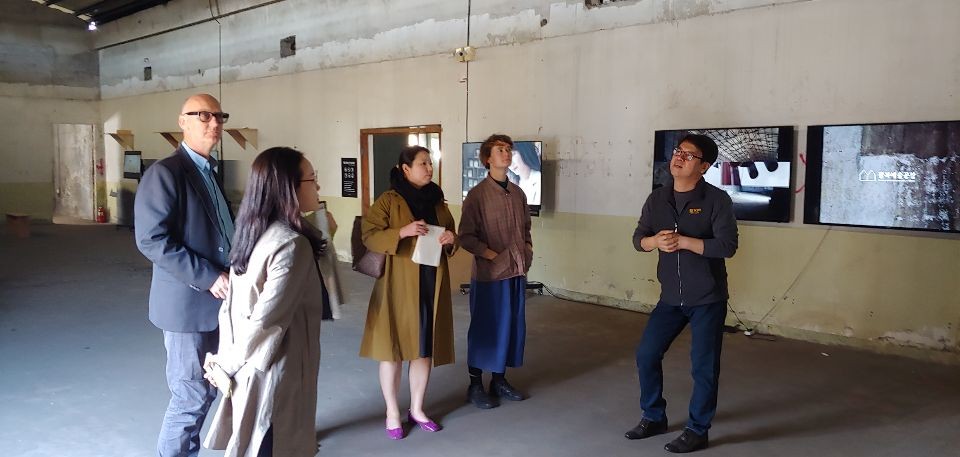
Essentially these newly developed spaces will support creative activity by providing dedicated spaces that display some of the following:
- A space that reflects the activity that is going to go on inside: If you intend to ‘preach and teach’ to a passive audience then you need a space where the seats are in rows and the teacher is at the head of the class, however if you want to create open learning spaces where all participants become teachers and learners together, then a different form is needed. Open and flexible areas that allow for democratic control of space is vital to break the mould of teacher/learner. Teaching artists thrive in spaces where they are able to move between being primarily a teacher or a learner. Creating spaces where participants become researchers through practice is critical in empowering individuals and groups through creativity.
- Spaces that enable interdisciplinary approaches: Open spaces encouraging users to use a variety of materials in a range of ways are important in supporting imaginative playfulness. Providing space that doesn’t feel too precious is critical is supporting creative risk.
- A place that gives status to teaching artistry: for too long Teaching Artists have had to
‘make-do’ with secondary places to deliver programs. A Teaching Artist, or Socially Engaged
Artist, will benefit from purpose designed spaces that enable them to do their job the best they can. This will reflect on their work and give higher status to their outcomes for participants, as well as modelling good practice for others.
- Places for people to gather and be together: Creative activities give people the opportunities to build new and solid relationships through shared making. Collaborative creativity builds trust and empathy, allowing people to share their viewpoints of the world. In addition these spaces offer the opportunity for Teaching Artists and their colleagues to gather and share practice – building their capacity to improve their own work and build the capacity of their sector.
- Embedding storytelling through the arts within spaces of history: Refurbishing old buildings that contain a sea of stories from the past encourages a new cycle of storytelling and sharing of new personal and cultural experiences.
- Flexibility in design that supports inclusive engagements by the public: People need a variety of learning resources and materials – offering spaces where that flexibility is inherent supports diversity and personalised learning and sharing. With ongoing projects, participants of all ages are able to become co-designers of the spaces in which they are working – encouraging higher engagement and a greater sense of ownership.
- Spaces that evidence sustainability describe how the practice of making and doing can also embrace sustainable approache: Authentic and well-worn materials provide highly suitable environments encouraging the use of similarly authentic and recycled materials by teaching artists and participants alike.
- A space that reflects the activity that is going to go on inside: If you intend to ‘preach and teach’ to a passive audience then you need a space where the seats are in rows and the teacher is at the head of the class, however if you want to create open learning spaces where all participants become teachers and learners together, then a different form is needed. Open and flexible areas that allow for democratic control of space is vital to break the mould of teacher/learner. Teaching artists thrive in spaces where they are able to move between being primarily a teacher or a learner. Creating spaces where participants become researchers through practice is critical in empowering individuals and groups through creativity.
- Spaces that enable interdisciplinary approaches: Open spaces encouraging users to use a variety of materials in a range of ways are important in supporting imaginative playfulness. Providing space that doesn’t feel too precious is critical is supporting creative risk.
- A place that gives status to teaching artistry: for too long Teaching Artists have had to
‘make-do’ with secondary places to deliver programs. A Teaching Artist, or Socially Engaged
Artist, will benefit from purpose designed spaces that enable them to do their job the best they can. This will reflect on their work and give higher status to their outcomes for participants, as well as modelling good practice for others.
- Places for people to gather and be together: Creative activities give people the opportunities to build new and solid relationships through shared making. Collaborative creativity builds trust and empathy, allowing people to share their viewpoints of the world. In addition these spaces offer the opportunity for Teaching Artists and their colleagues to gather and share practice – building their capacity to improve their own work and build the capacity of their sector.
- Embedding storytelling through the arts within spaces of history: Refurbishing old buildings that contain a sea of stories from the past encourages a new cycle of storytelling and sharing of new personal and cultural experiences.
- Flexibility in design that supports inclusive engagements by the public: People need a variety of learning resources and materials – offering spaces where that flexibility is inherent supports diversity and personalised learning and sharing. With ongoing projects, participants of all ages are able to become co-designers of the spaces in which they are working – encouraging higher engagement and a greater sense of ownership.
- Spaces that evidence sustainability describe how the practice of making and doing can also embrace sustainable approache: Authentic and well-worn materials provide highly suitable environments encouraging the use of similarly authentic and recycled materials by teaching artists and participants alike.
- Creative Dreaming: Simply the idea of spaces that support creative dreaming and innovative cross-overs of cultural and social expectations can free participants in creative programs to
‘think outside the box’ and be more exploratory themselves.
- Playfulness and fun: A playfulness with materials, place names and resources will encourage the interactions between artists and participants to be fun and enjoyable. These will become places for people to laugh and create together.
- Enlightened leadership: Places where the leadership and curation of the spaces is open to multimodal creativity and learning, and where creative risk is encouraged supports the long- term creation of cohesive and productive engaged citizens. The leadership of these spaces is so frequently overlooked and is critical to building a team of like-minded staff at all levels within the building.
These spaces embody a set of values that embrace inclusion, sustainability and democracy. They acknowledge that creating together in intergenerational groups fosters a sense of ownership, engagement and citizenship. Sharing recipes becomes symbolic of sharing culture, and creating large drawings together reflects a trust and celebration of difference.
Do we need these spaces for teaching artistry to flourish? Good teaching artistry has survived without, but what a difference to have new purpose built spaces bringing more people into the world of making and offering Teaching Artists an opportunity to develop new approaches and ideas in inspiring and open environments. These spaces represent the future – a new way of working and creating together.
I wish these new spaces in Korea all the best and intend to be back at ITAC 2020 when I might get the opportunity to visit them again to see how they are doing!
*Posted by Simon Spain(Co-director of All That We Are)
△Conference at B39
△Forum at Palbok
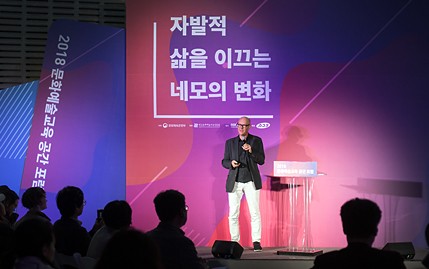
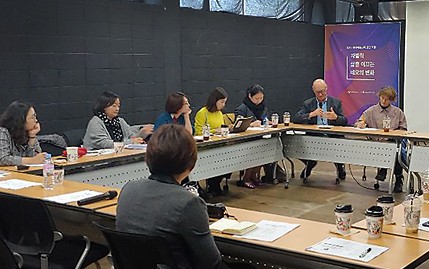
© 1970 KACES
Brief News 1 - <KACES to host the 5th International Teaching Artist Conference (ITAC5)>
At the closing ceremony of the 4th International Teaching Artist Conference (ITAC4) held in the Weill Music Room of New York's Carnegie Hall, KACES announced that it will host the 5th International Teaching Artist Conference (ITAC5) in Seoul in 2020.
Since 2012, ITAC has been held every other year as a platform for exchange among leading arts and culture education experts from around the globe. Upon the ITAC Committee's proposal in 2016 to host the conference, Korea conducted extensive deliberation with both domestic and international stakeholders to initiate efficient and proper planning for the event. The official invitation was presented to attend the ITAC4, where Korea outlined the steps it has taken over the years and, in turn, officially invited international stakeholders to attend in 2020.
In giving her address, KACES President Hyun Mee Yang announced "Boundaries into Pathways" as the slogan for ITAC5, calling for a paradigm shift in arts and culture education in which obstacles and boundaries could become new unions or pathways for meeting through creativity and imagination. KACES plans to further develop themes for ITAC5 reflecting the support shown by those present at this year's conference.
Since 2012, ITAC has been held every other year as a platform for exchange among leading arts and culture education experts from around the globe. Upon the ITAC Committee's proposal in 2016 to host the conference, Korea conducted extensive deliberation with both domestic and international stakeholders to initiate efficient and proper planning for the event. The official invitation was presented to attend the ITAC4, where Korea outlined the steps it has taken over the years and, in turn, officially invited international stakeholders to attend in 2020.
In giving her address, KACES President Hyun Mee Yang announced "Boundaries into Pathways" as the slogan for ITAC5, calling for a paradigm shift in arts and culture education in which obstacles and boundaries could become new unions or pathways for meeting through creativity and imagination. KACES plans to further develop themes for ITAC5 reflecting the support shown by those present at this year's conference.
© 1970 KACES
Brief News 2 - <KACES signs MOU with Kadenze for online-based, global teaching artistry training>
Upon signing an MOU with Kadenze, Inc. for online-based, global teaching artistry training, KACES confirmed its plans to collaborate in efforts to provide arts and culture education to stakeholders with opportunities to experience global teaching artistry content.
Kadenze, Inc. is an online academic platform that provides high-quality lessons in science, technology, arts, design, and music through collaborations with leading STEAM (science, technology, engineering, arts, mathematics) education institutes around the world. Kadenze and KACES have conducted collaborative efforts since the launch of "Basics of Teaching Artistry".
The MOU outlines that the two organizations will:
1. To adapt, develop and create relevant and high-quality online content to advance the field of Teaching Artistry both in the Republic of Korea(ROK) and globally. The focus of this work will be for the professional development and training of teaching artists and of those who have an interest in this field.
2. To develop and deliver quality teaching artistry content for online presentation and consumption, hosted on Kadenze’s online platforms, including kadenze.com and, as needed, the underlying Kannu software.
3. To mutually collaborate based on the specialty and expertise of both organizations, foster friendships and pursue the mid to long-term development of both organizations.
This is the first collaborative project to be conducted between KACES and Kadenze, and production of course package for the Korean language for the "Basics of Teaching Artistry" began in November. This course consists of a series of lessons with participating experts from leading arts and culture institutions, including the Lincoln Center Institute, the Queensland Performing Arts Centre, and the Sydney Opera House. KACES plans to r expand not only translation services for this program but further collaborative projects in the future.
Kadenze, Inc. is an online academic platform that provides high-quality lessons in science, technology, arts, design, and music through collaborations with leading STEAM (science, technology, engineering, arts, mathematics) education institutes around the world. Kadenze and KACES have conducted collaborative efforts since the launch of "Basics of Teaching Artistry".
The MOU outlines that the two organizations will:
1. To adapt, develop and create relevant and high-quality online content to advance the field of Teaching Artistry both in the Republic of Korea(ROK) and globally. The focus of this work will be for the professional development and training of teaching artists and of those who have an interest in this field.
2. To develop and deliver quality teaching artistry content for online presentation and consumption, hosted on Kadenze’s online platforms, including kadenze.com and, as needed, the underlying Kannu software.
3. To mutually collaborate based on the specialty and expertise of both organizations, foster friendships and pursue the mid to long-term development of both organizations.
This is the first collaborative project to be conducted between KACES and Kadenze, and production of course package for the Korean language for the "Basics of Teaching Artistry" began in November. This course consists of a series of lessons with participating experts from leading arts and culture institutions, including the Lincoln Center Institute, the Queensland Performing Arts Centre, and the Sydney Opera House. KACES plans to r expand not only translation services for this program but further collaborative projects in the future.
© 1970 KACES
Brief News 3 - <KACES and Korean Cultural Center Vietnam shares arts and culture education ODA results at “Teaching Artistry in the Digital Age” exhibition and workshop>
The <Arts and Culture Education ODA> conducted from 2013~2017 in the Lào Cai region, located in northern Vietnam and home to several minority groups, involved photography, visual arts, dance, and theater training programs for local teachers of young children and adolescents. This project used art not only to positively influence participants but also to achieve many impressive results, namely helping professional artists and teaching artistry coordinators to further promote their careers in the field.
Marking another five years since the implementation of the ODA, this year's major projects included needs-based programs for local schools to promote reading among youth in the Lào Cai region. This project took a new approach to arts and culture education, using digital materials to teach theater education through famous literary works, with the goal of improving digital literacy. As an extension of this project, particularly in the field of digital literacy, upon completing the program on-site in Vietnam, Korean teaching artists in Seoul participated in remote education with local residents in Lào Cai to support ongoing efforts in education. This marked the first ever remote education program to be conducted there, thus garnering much attention from relevant stakeholders in the region.
For this event, in an effort to demonstrate what they learned through the Korea-Vietnam ODA program, high school students from Lào Cai came to Hanoi and put on a VR art performance, which consisted of VR art and various other forms of media art. They also prepared an exhibition on AI projects and a workshop where participants could experience different education methods first-hand.
Marking another five years since the implementation of the ODA, this year's major projects included needs-based programs for local schools to promote reading among youth in the Lào Cai region. This project took a new approach to arts and culture education, using digital materials to teach theater education through famous literary works, with the goal of improving digital literacy. As an extension of this project, particularly in the field of digital literacy, upon completing the program on-site in Vietnam, Korean teaching artists in Seoul participated in remote education with local residents in Lào Cai to support ongoing efforts in education. This marked the first ever remote education program to be conducted there, thus garnering much attention from relevant stakeholders in the region.
For this event, in an effort to demonstrate what they learned through the Korea-Vietnam ODA program, high school students from Lào Cai came to Hanoi and put on a VR art performance, which consisted of VR art and various other forms of media art. They also prepared an exhibition on AI projects and a workshop where participants could experience different education methods first-hand.
© 1970 KACES